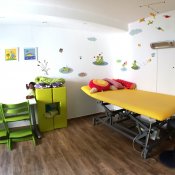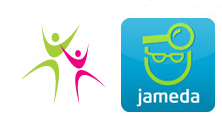Manual Therapy
Manual therapy is a complex treatment of movement disorders of the functional unity joint – muscle – nerve by means of translational joint mobilisation, active and passive stretching of shortened muscular structures and invigoration of their weakened antagonists. At the same time, the patient is trained in various joint and muscle exercises. The therapeutic techniques support the recovery of physiological joint functions and aim at maintaining them.
Therapy of Craniomandibular Dysfunction (Mandibular Joint Problems)
Craniomandibular dysfunctions (CMD) are functional disorders which are caused by the malposi-tion between cranium (skull) and mandible (lower jaw-bone). This functional disorder of the man-dibular joint can lead to e.g. painful limitations in mobility if the patient wants to open the mouth. Also a dislocation of the lower jaw-bone is possible. This happens when the joint head of the mandibular joint is located incorrectly in the socket due to the malposition. Most, it is not easy for the patient to exactly locate the pain.
Craniomandibular dysfunctions can also cause headache, tinnitus or maxillofacial pains.
Mucoviscidosis Treatment
Physiotherapy for Mucoviscidosis Patients
Characteristics of the Disease
One of the characteristics of mucoviscidosis (cystic fibrosis (CF)) is the ob-struction of the respiratory tract (bronchia) with pathologically alternated thick mucus. This mucus impedes the gas exchange and, thus, the nourishment of the body with oxygen. Due to the cough typical for this disease, the patient cannot remove the mucus out of the bronchia (dysfunction of the cough clearance).
How does physiotherapy look like?
Thus, the patient has to make use of particular physiotherapeutic respiratory techniques and treatments. Summarized by the term physiotherapy, this in-cludes a number of specially developed techniques and breathing exercises that enables the patient to dissolve the tight mucus from the bronchial wall and to transport it to the top to the mouth where it can be coughed up.
Techniques of Physiotherapy
The most popular technique is the (modified) autogenic drainage. This natural purification technique is very effective, can be applied independently but de-mands a high level of concentration and self-discipline of the patient and re-quires frequent control through specialised physiotherapists. It is the foundation for many other breathing therapies such as inhalation by means of which mu-colytic and antiphlogistic medicine is supposed to be inserted into the bronchia as effectively as possible.
Furthermore, respiratory assisting devices such as VRP I Flutter, PEP devices and RC-Cornet are applied. They support the expiratory phase and additionally contribute to dissolving the mucus. Expeditiously, they can be combined with autogenic drainage, inhalation and physiotherapeutic techniques.
Area of Responsibility
The area of responsibility of the physiotherapist necessarily spans physiother-apeutic exercises in order to support and maintain a mobile thorax (mobilisation exercises).
Besides, the CF physiotherapist has to encourage the patient to increased physical activity as this plays an important role in the purification of the bron-chia and promotes the preservation and improvement of the pulmonary func-tion.
The Role of the Physiotherapist
The CF physiotherapist has a key role in the treatment of mucoviscidosis. In consultation with the ambulance physician in charge, the therapist provides a program individualized for the patient’s lung condition and general state of health. Frequent examinations of the breathing technique and adjustments to pathological changes are inevitable.
The necessity of daily and life-long physiotherapy treatment/physiotherapeutic breathing techniques is encumbering for the patients and their parents. Also for that reason, the patient needs professional care and assistance.
Manual Lymphatic Drainage
The effects of the manual lymphatic drainage are wide-ranging. Mainly, it serves as oedema and decongestion therapy of swollen body parts such as trunk and limbs (arms and legs). With circular pushing techniques, existing fluid is pushed with slight pressure out of the tissue into the lym-phatic system. The manual lymphatic drainage mainly affects the skin and the subcutaneous tissue and is not supposed to increase the blood flow as in the classic massage.
It proves useful also in pain management as well as before and after surgery by decongesting swollen tissue overloaded with cell liquid. The patient feels considerable relief, fewer analgesics are required and the healing process is faster. Contraindications must precisely be adhered to. In case of distinctive lymphatic diseases (congestions), this kind of therapy is combined with com-pression bandages, skin care and a specific movement therapy. It is then summarized by the term "complex physical decongestive therapy".
Therapy acc. to Bobath for Adults
Parkinson’s disease, multiple sclerosis (MS), stroke
Scoliosis Therapy acc. to Schroth
What is scoliosis therapy acc. to Schroth?
Scoliosis is a partly fixed lateral deviation of the spinal column with a contortion of the vertebral bodies and, especially in case of the idiopathic scoliosis, with development of a flat back. The three-dimensional scoliosis treatment acc. to Schroth is a deformation-specific back therapy train-ing which works against the above-mentioned alterations. This happens through:
• Active posture correction of spine and thorax considering all present curvatures,
• Changes in the awareness of the posture by independently repeating the posture correc-tions, reflex activation of posture corrections and sub-maximal tension of the posture muscles in optimal correction,
• Supporting posture corrections by corrective breathing techniques that can fill sunken parts of the trunk over the long rib lever and corrects the scoliotic breathing pattern.
As has been proven, daily, intensive exercise increases a posture-awareness optimal for the pa-tient, especially during the juvenile growth phase. The three-dimensional scoliosis treatment acc. to SCHROTH was developed between 1910 and 1920 by Ms Katharina Schroth and successfully applied on patients in 1921 onwards in her own institute. There are several important publications of the research department of the Katharina Schroth Clinic, founded in 1988, which especially refer to the physiotherapeutic treatment of scoliosis patients.
Respiratory Therapy
The clinical (medical) respiratory therapy deals with diseases and functional disorders of lung and glottis. It serves as prevention as well as after-treatment. The main goals of the respiratory therapy are the following:
• Pneumonia prevention
• Liquefaction and transport of secretions
• Stabilisation/development of a stabile bronchial system, in particular in case of obstructive diseases (chronic bronchitis, asthma etc.)
The breathing training is part of the respiratory therapy. This training includes various techniques to improve the lung capacity. To achieve this, especially the breast muscles are strengthened and techniques to increase the belly breathing are trained.
Effect
An effective breathing therapy is supposed to contribute to the reduction of breath repressive re-sistance, the reduction of incorrect breathing forms, the liquefaction of secretion, an increase in ventilation, the invigoration of the respiratory muscles and a general increase in physical fitness.
Massage
Indications for a classic massage are tensions, indurations, diseases of the locomotor system such as spinal column syndromes as well as post-traumatic alterations. Through reflexive bows, diseases of the inner organs become apparent at the skin or the muscles. Another area of applica-tion of the massage is the specific field of neurology. Here, especially pareses, spasticity, neuralgia and sensibility disorders can be treated. Additionally, psychosomatic diseases caused by stress that mainly refer to the heart and blood circle are treated.
Hot Air, Fango, Ice Treatment
Hot air is a form of thermo treatment with the aid of an infrared radiator. Red light is mostly used as pre-treatment for the classic massage therapy.
The principle of fango is the following: paraffin fango plates are heated in the oven and can, thus, be modelled to the respective body parts. Fango is often used directly before a massage in order to increase the blood flow.
Ice treatment is a treatment in form of ice compresses (terrycloth plunged in icy water respectively filled with ice cubes or frozen with salt water), deep-frozen cold gel sacs (jellylike silicate welded in hardwearing plastic foil or plastic sacs filled with icy water), direct rubdown (ice massage, ice in-unctions), cold gas and cold air with respective devices as well as partly baths with icy water in feet or arm tubes with local application of intensive cold in order to reduce inflammation, abate pain sensitivity and the metabolism as well as to relax hypertonic and tensed musculature.
House Calls
By request respectively according to medical prescription, we also visit you at home. Please feel free to contact us.




